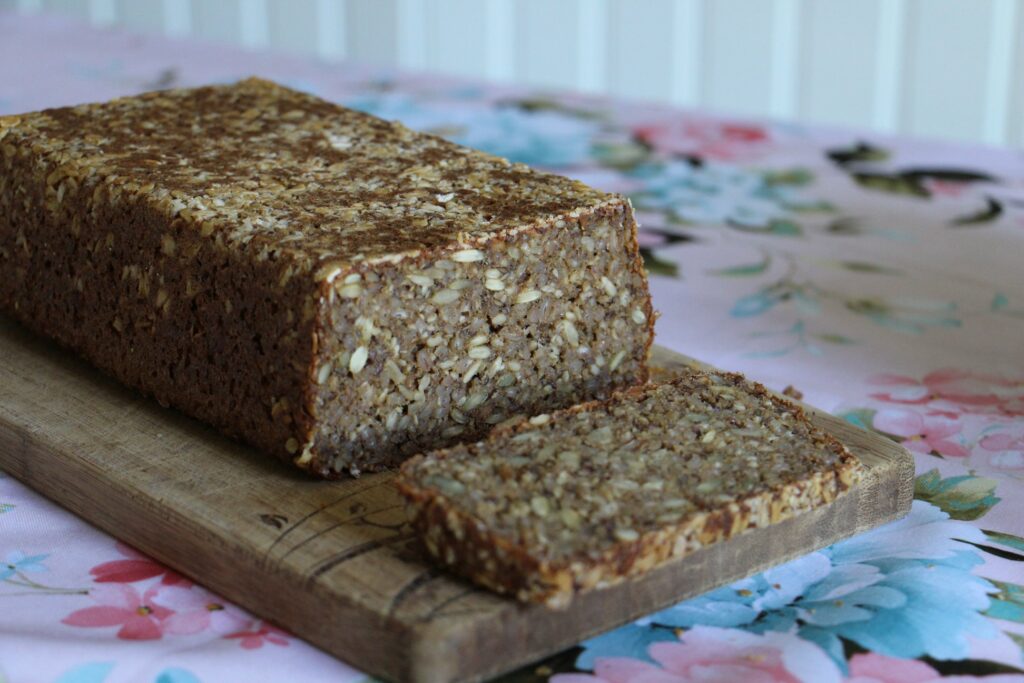
Germany has over 3,000 varieties of bread. Some are dense, dark and chewy like pumpernickel, and others are light and airy like the morning Brötchen. Bread is a twice a day staple in Germany. The Germans enjoy their morning bread with butter and jam, and their Abendbrot (evening bread/dinner) with a slice of cheese and meat.
This bread recipe is called Kornbeißer Brot, or grain biter bread. It’s a dark rye bread made with rye berries, rye flour, and a large amount of mixed seeds. Unlike many dark rye breads, this one is a simple version that uses yeast instead of sourdough, so its perfect for a beginner bread baker.
If you’re in the United States like me, you may have a hard time sourcing rye berries. I’ve had luck finding them at health food stores.
I hope you try out this recipe. It’s perfect for open-faced sandwiches or morning toast.

German Seeded Rye Bread / Kornbeißer Brot
Ingredients
Method
- Coarsely grind the rye berries.
- Combine the boiling water and rye berries in a bowl and then cover and let rest for one hour. The berries will absorb the liquid and become soft. If any liquid remains after one hour, drain before combining with the rest of the ingredients.
- Next add your yeast to a mixer, along with the lukewarm water and molasses. Stir until yeast is dissolved. If using active dry yeast, let sit for 5 minutes until yeast becomes foamy before adding in the other ingredients.
- Add in the rye flour, soaked rye berries, salt, and mixed seeds. Using the dough hook attachment of your mixer, mix on medium speed until well combined. Scrape down the sides of the bowl as necessary.
- Once the ingredients are well combined, mix on medium speed for 8 minutes.
- Cover the bowl and place in a warm spot to rise. This will take about one hour, possibly more or less depending on the temperature of your home.
- While waiting for the dough to rise, oil the loaf pan and sprinkle with old-fashioned rolled oats.
- Once the dough has about doubled in size, pour into the prepared loaf pan. Using a spatula, lightly press the dough into the pan until the dough is compact and smooth on the surface.
- Place on the bottom rack of a 240C/460F preheated oven for 10 minutes. Then reduced the temperature to 200C/400F for 40-50 minutes until golden brown and hollow when tapped. Let cool and then use a bread knife to slice and enjoy.
Video
Notes
- If your rye berries don’t absorb all of the boiling water, drain before combining with the rest of the ingredients.
- I’ve had a lot of feedback on the salt amount, so I’m permanently changing the recipe to 10 grams of salt, even though the video tutorial states 20 grams.

Thank you for this recipe! I made this bread several times now and will continue making it. It is so hard to find descend “fresh” Ryebread (Schwarzbrot) here in the Midwest. I adjusted the amount of salt used in this recipe. 20gr. of salt is a bit too much for my taste so first I went down to 15 gr. (still too much) and I settled with 10 gr. of salt.
I’m happy to hear you’ve been enjoying this bread! Thank you for the feedback on the salt. I’ve had a lot of others mention the salt amount, so I’m going to permanently adjust the recipe to 10 grams.
I made a wheatberry version. It’s in the oven now. I soaked the wheatberries in cold water overnight, and they softened up nicely. I added them whole with some extra flour whole wheat. For seeds, I used pumpkin, sunflower, sesame, and a mix of quinoa, millet, and buckwheat.
Just took it out and it’s gorgeous and delicious, too!
Vielen dank für das Rezept!
Wonderful! I’m so glad it turned out for you!
Have you tried Celtic sea salt?
It is sweeter and full of trace minerals.
To me more if this salt is better.
Olav
I have! It’s a great salt to use
Great recipe. On my list for this coming week. Try toasting the sunflower seeds, much better flavor. Should soak flaxseed, easier to digest.
Cannot find rye berries here…what can use instead?
You could try wheat berries, if you can’t find rye, though I’ve never tried this myself. Which country are you in? Oftentimes, they can be ordered online for a good price.
High! Awesome receipe, I will try it in Argentina. Every time I come back from Germany I inmmediately start missing this type of bread.
Question:
What can I use to replace the molasses if I don’t get it back in my country, and by the way what exactly is this? From what I saw, it is kind a sweet syrup but from which fruit? Or does it just come from sugar?
Thanks for sharing!
Hi Julian, thank you!
Molasses is made from sugarcane in the process of refining. It is a dark, thick, sweet syrup with a distinct after taste. I am a bit surprised to hear that you cannot get molasses in Argentina, but I wonder if you could acquire it through Amazon? You really cannot replace the flavor, but if you would like to experiment, you could try any other sweet syrup. Let me know how it works for you!
Perhaps look for treacle or dark treacle?
I love the flavour of this bread, but I am struggling to get it cooked through properly. It comes out slightly soggy in the middle, even after longer cooking time. Any suggestions?
I would suggest buying a probe thermometer (they can be ordered pretty inexpensively online) and taking the internal temperature of the bread before removing it from the oven. It should be between 205-210F (96-99C) at the thickest part of the bread. My other suggestion would be to look at the consistency of your soaked rye berries. If there is any remaining liquid after soaking, discard that before adding them to the rest of the ingredients. Let me know if it ends up working out for you! For a faster response if you have further questions, feel free to email me at bake across europe at gmail dot com.
Love this bread. – I added 10g of salt and for us it is still too much. I used date syrup but need to increase the amount. I added caraway seeds + think I need to soak my rye berries for longer as they were still quite hard. However – it’s still great!! Thank you for the recipe.
I made this bread yesterday. My rye berries were like rock after soaking for an hour; I was hoping they would soften while baking. No such luck. I had to toss the bread. It was awful. I read another recipe for this type of bread and they instruct you to soak the berries overnight then cover them with boiling water and soak for another hour. I will do this next time; I may even put them in my InstaPot to hydrate them like I do for beans.
followed to the letter.. did add caraway. Excellent results.
Cook to a temperature of 210 min. for sure to avoid wetness.
I’m glad you enjoyed it!